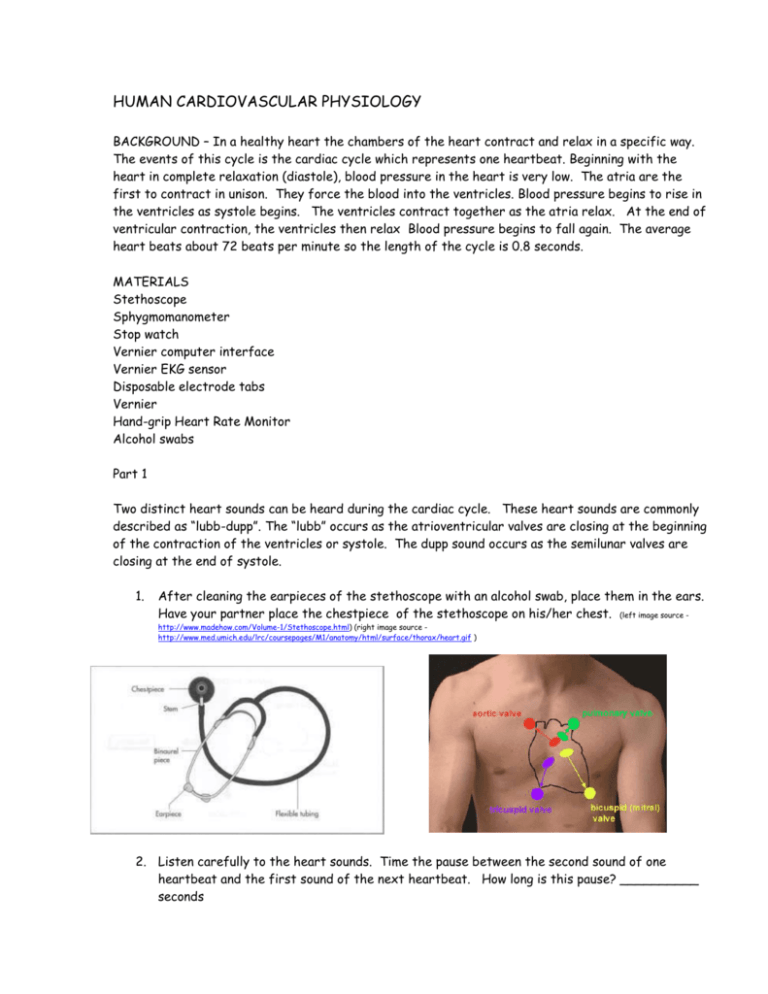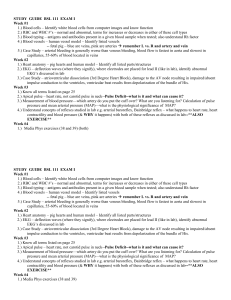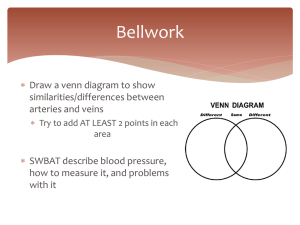HUMAN CARDIOVASCULAR PHYSIOLOGY
advertisement

HUMAN CARDIOVASCULAR PHYSIOLOGY BACKGROUND – In a healthy heart the chambers of the heart contract and relax in a specific way. The events of this cycle is the cardiac cycle which represents one heartbeat. Beginning with the heart in complete relaxation (diastole), blood pressure in the heart is very low. The atria are the first to contract in unison. They force the blood into the ventricles. Blood pressure begins to rise in the ventricles as systole begins. The ventricles contract together as the atria relax. At the end of ventricular contraction, the ventricles then relax Blood pressure begins to fall again. The average heart beats about 72 beats per minute so the length of the cycle is 0.8 seconds. MATERIALS Stethoscope Sphygmomanometer Stop watch Vernier computer interface Vernier EKG sensor Disposable electrode tabs Vernier Hand-grip Heart Rate Monitor Alcohol swabs Part 1 Two distinct heart sounds can be heard during the cardiac cycle. These heart sounds are commonly described as “lubb-dupp”. The “lubb” occurs as the atrioventricular valves are closing at the beginning of the contraction of the ventricles or systole. The dupp sound occurs as the semilunar valves are closing at the end of systole. 1. After cleaning the earpieces of the stethoscope with an alcohol swab, place them in the ears. Have your partner place the chestpiece of the stethoscope on his/her chest. (left image source http://www.madehow.com/Volume-1/Stethoscope.html) (right image source http://www.med.umich.edu/lrc/coursepages/M1/anatomy/html/surface/thorax/heart.gif ) 2. Listen carefully to the heart sounds. Time the pause between the second sound of one heartbeat and the first sound of the next heartbeat. How long is this pause? __________ seconds PART 2 Pulse is the surges of pressure (expansion and then recoil) in an artery that occur when the ventricles contract. Normally, the pulse rate equals the heart rate and averages 70-76 beats per minute while at rest. 1. Palpate (feel) the pulse on your partner by placing the fingertips (not the thumb) over the artery. Try to find the pulse of your partner at the following locations: radial artery, carotid artery, and brachial artery. Refer to the diagram below. (image source - http://www.rsc-swscotland.ac.uk/measuring_techniques/images/pic004.gif ) 2. The pulse most often used is the radial pulse. With your partner seated, count the radial pulse for one minute. Make three counts and then average. Trial 1 ___________ Trial 2 ____________ Trial 3 __________ Average ___________ 3. With your partner sitting quietly, have another student take the radial pulse of your partner while you use a stethoscope to determine heart rate. The person doing the radial pulse should begin the time period for the count. Record your counts at the same time for exactly one minute. Stethoscope count ________ Radial pulse ___________ Difference ___________ PART 2 The sphygmomanometer or “blood pressure cuff” is used to measure blood pressure.The cuff bladder is inflated and a stethoscope is used to hear the sounds of Korotkoff while over the brachial artery. The pressure at which the first soft tapping sound is heard is the systolic pressure. When the sounds can no longer be heard, this pressure is recorded as the diastolic pressure. 1. Work in pairs. Swab the earpieces with alcohol swabs. Be sure the bladder in the cuff is completely deflated. 2. Have your partner rest their left arm rest on the table extended. Wrap the cuff around your partner’s arm, just above the elbow (usually about an inch above). The cuff should be snug enough to insert a finger under the cuff. Locate the pulse of the brachial artery with your fingertips and then position the chestpiece of the stethoscope just to the right of the brachial artery. 3. Insert earpieces of stethoscope in your ears. Close the valve on the bulb pump by turning it clockwise. Begin inflating the bladder of the cuff by squeezing the bulb pump until the gauge reaches about 160 mm Hg pressure. Slowly turn the valve of the bulb pump counter clockwise to open to release the air in the bladder SLOWLY (ABOUT 2-3 mm Hg per second). WARNING: THE INFLATED CUFF CUTS OFF THE CIRCULATION OF THE ARM AND SHOULD NOT REMAIN INFLATED ANY LONGER THAN NECESSARY! 4. Watch the gauge as you listen for the first soft thumping sounds – make a mental note of this pressure. Continue to listen and release pressure from the cuff. When you hear the LAST sound, note the pressure reading on the gauge. Open the valve of the bulb pump and rapidly release the air in the bladder of the cuff. Record your results and repeat again. First trial: Systolic pressure ____________ Diastolic pressure ___________ Second trial: Systolic pressure ___________ Diastolic pressure ____________ PART 3 An electrocardiogram (EKG) is a graphical tracing of the electrical events that occur within the heart cycle. An EKG consists of three waves: P wave, QRS wave and T wave. The P wave is the depolzarization of the atria. The QRS wave is the depolarization of the ventricles. The T wave is the repolarization of the ventricles. An EKG is valuable in diagnosing heart disease or ailments that can damage the heart. (image source - http://www.vetgo.com/cardio/concepts/images/qrs_durs.JPG ) 1. Connect the EKG sensor to the computer interface. Prepare the computer for data collection by opening the “28 Monitoring EKG” file. 2. Scrub the areas of the skin where the electrodes will be attached – the inside of both elbows and the inside of the right wrist. 3. Attach the electrode tabs to your partner’s arms, one on the inside right wrist, one on inside right elbow and one on left inside elbow. Attach the tabs so that the silver bar of the tab is toward the fingertips. 4. Attach the EKG clips (see picture below) in the following order. Attach the green clip to the right elbow, the red 5. 6. 7. 8. clip to the left elbow, and the black clip to the right wrist. Have your partner sit with arms hanging down to the side unsupported. Click “Collect” on the toolbar of the computer program to begin data collection. When data collection is complete, click on Experiment file and also on “store latest run”. Click on the examine button to analyze the data or print the graph so that data can be analyzed later. Using the diagram above to label one heart cycle on your print out. Calculate the heart rate in beats per minute using the data collected. One heartbeat is represented by the amount of time between the QRS peaks. Use the equation below to calculate heart rate: #beats = 1 beat X minute ___ seconds 60 seconds 1 minute 9. Using your printed copy of the data complete the table under analysis. 10. Click on experiment and click on “clear latest run”. Disconnect the alligator clips but do not remove the electrode patches from the skin. PART 4 1. Reapply the blood pressure cuff (DO NOT REMOVE THE ELECTRODE PATCHES). 2. Have your partner exercise for three minutes by jogging in place. 3. Quickly take your partner’s blood pressure and record. 4. Reattach the alligator clips to the electrode patches and record a new EKG by clicking on the “collect” button in the toolbar. Take your partner’s radial pulse. 5. When data collection is complete, click on Experiment file and also on “store latest run”. 6. Print this graph. Compare this graph to the results of the first EKG. 7. Record your data: Systolic pressure ____________ Diastolic pressure ___________ Radial pulse ____________ ANALYSIS DATA FROM NORMAL EKG INTERVAL TIME IN SECONDS P-R QRS Q-T HEART RATE ___ BEATS PER MINUTE 1. Does the pulse regular like the ticking of a clock or does it seem to skip beats? Why do you suppose? 2. Of the three pulse points tested, which seems to have the greatest amplitude? Why do you think this is so? 3. After exercise, what might be the explanation for a greater elevation in both blood pressure and pulse? 4. The EKG is a tool used to diagnose certain types of heart disease. Why is it important to look at the intervals of the different waves? 5. After listening to the heart sounds with a stethoscope, what differences of the two sounds did you observe? 6. Certainly after a lab you are not a physician, however, based on what you have learned in this lab, how might abnormal results in any part of the lab might be used to diagnose heart problems? (You should use your textbook. ) 7. Explain the appearance and disappearance of the sounds of Korotkoff when taking blood pressure. 8. What would a blood pressure of 145/85 mean?







